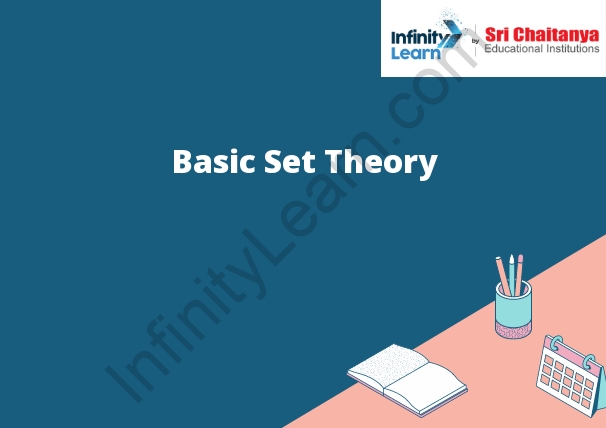Table of Contents
Set Theory Symbols chart
There are a few symbols that are used in set theory. The most common are:
∈: This symbol means “is an element of.” So, for example, if we wanted to say that the set of all natural numbers is an element of the set of all integers, we would write:
{1, 2, 3, 4, 5, 6, 7, 8, 9, 10} ∈ {-5, -4, -3, -2, -1, 0, 1, 2, 3, 4, 5}
The symbol ∈ is read “is an element of.”
∩: This symbol means “intersection.” The intersection of two sets is the set of all elements that are in both sets. So, for example, if we wanted to say that the set of all natural numbers and the set of all even numbers have the same elements, we would write:
{1, 2, 3, 4, 5, 6, 7, 8, 9, 10} ∩ {2, 4, 6, 8, 10, 12, 14, 16, 18, 20}
The symbol ∩ is read “intersection.”
∪: This symbol means “union.” The union of two sets is the set of all elements that are in either set. So, for example, if we wanted to say that the set of all natural numbers or the set of

Set Theory
In mathematics, set theory is the branch of mathematics that deals with the properties of sets, which are collections of objects. In set theory, a set is a collection of objects that are distinguished from each other by their properties.
The most fundamental concept in set theory is the set itself. A set is a collection of objects that are distinguished from each other by their properties. The objects in a set can be anything, including numbers, letters, shapes, or other sets.
The properties that distinguish the objects in a set can be any property, including the objects’ color, shape, size, or location. The only requirement is that the objects in a set have some property in common that distinguishes them from all other objects.
For example, the set of all red objects can be defined as the set of all objects that have the color red. The set of all square objects can be defined as the set of all objects that have the shape of a square. The set of all objects that are located in the United States can be defined as the set of all objects that have the location property of the United States.
The objects in a set can be listed in any order. In the set of all red objects, for example, the objects could be listed as red apple, red balloon, red car, and so on.
Sets can be described in mathematical notation using the curly braces, { }, to indicate that the enclosed objects are a set
Set Theory Definition
Set theory is a branch of mathematics that deals with the properties and relations of sets. A set is a collection of objects that are can be uniquely identified. In set theory, sets are usually denoted by capital letters, such as A, B, C, etc.
The most fundamental property of a set is its membership. A set is said to contain an object if that object is a member of the set. The set A, for example, contains the object 1, the object 2, and the object 3. The set B, on the other hand, does not contain the object 1, but does contain the object 2 and the object 3.
A set can be described in terms of its elements and its properties. For example, the set A can be described as the set of all natural numbers less than 10. The set B can be described as the set of all even numbers less than 20.
One of the most important properties of a set is its cardinality. The cardinality of a set is the number of objects in the set. The cardinality of the set A is 10, while the cardinality of the set B is 20.
Sets can be compared using various set operations. The most basic set operation is union. The union of two sets is the set containing all of the objects that are members of either set. The set A, for example, has the union set A∪B, which contains the objects
Set Theory Rules
A set is a collection of objects.
The objects in a set are called elements or members of the set.
Two sets are equal if they have the same elements.
The cardinality of a set is the number of elements in the set.
A set can be represented by a set of curly braces {}.
The empty set is the set with no elements.
If A is a set, then A ∪ B is the set of all elements in A or B.
If A is a set, then A ∩ B is the set of all elements in A and B.
If A and B are sets, then A ⊆ B if and only if every element in A is also an element in B.
If A is a set, then A ≠ B if and only if there is no element in A that is also an element in B.
Set Representation
The set representation of a number is a way of writing a number as a set of unique objects. The number 5 can be written as {5,} or {1, 2, 3, 4, 5}.
Set Theory Symbols
The following symbols are used in set theory:
Union: The union of two sets A and B is the set of all elements that are in either A or B, or both.
Intersection: The intersection of two sets A and B is the set of all elements that are in both A and B.
Difference: The difference of two sets A and B is the set of all elements that are in A but not in B.
Complement: The complement of a set A is the set of all elements that are not in A.
Types of Sets
There are three types of sets:
The natural numbers: {1, 2, 3, 4, 5, 6, 7, 8, 9, 10}
The integers: {…, -3, -2, -1, 0, 1, 2, 3, 4, 5, 6, 7, 8, 9, 10}
The rational numbers: {…, 1/4, 1/2, 3/4, 1, 2, 3, 4, 5, 6, 7, 8, 9, 10}
1. What is a Subset in Maths?
A subset is a collection of elements from a larger set. The elements in the subset must all be from the larger set, and the subset must have a specific order or pattern. For example, the subset {1, 2, 3} is from the set {1, 2, 3, 4, 5, 6}.
2. What are the Proper Subsets?
The proper subsets of a set are the smaller sets that can be created from a larger set by taking away specific elements. For example, the proper subset of the set {1, 2, 3} would be the set {1, 2}.








